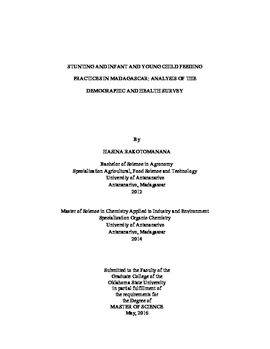| dc.contributor.advisor | Stoecker, Barbara J. | |
| dc.contributor.author | Rakotomanana, Hasina | |
| dc.date.accessioned | 2017-02-22T22:16:15Z | |
| dc.date.available | 2017-02-22T22:16:15Z | |
| dc.date.issued | 2016-05-01 | |
| dc.identifier.uri | https://hdl.handle.net/11244/49146 | |
| dc.description.abstract | Madagascar is among the countries with a dramatically high prevalence of stunting in children under 5 years old. This study used the latest Demographic and Health Survey (2009) to investigate determinants of child stunting according to the United Nations Children�s Fund (UNICEF) framework on the causes of malnutrition and to evaluate infant and young child feeding (IYCF) practices using the World Health Organization (WHO) indicators. Logistic regressions were performed to determine the variables associated with stunting and with inappropriate feeding practices. A cut-off at 24 months was used to separate the population into two groups. In 2009, 40.1% of the 1863 children aged 0-23 months and 53.9% of the 2911 children aged 24-59 months were stunted contributing to the 48.5% overall prevalence. In the younger group, boys (AOR=0.69 for girls), severely anemic children (AOR=3.50), children living in households that used non-iodized salt (AOR=0.76 for iodine content more than 15 ppm) and children living in rural areas (AOR=0.66 for urban) were more likely to be stunted. In the 24-59 months group, boys (AOR=0.84 for girls), moderately anemic children (AOR=1.79), children with incomplete immunization coverage (AOR=0.84 for full coverage), children whose mothers were breastfeeding (AOR=1.29), children who were perceived as small at birth (AOR=1.55) and children living in limited-resource households (AOR=3.13) were more likely to be stunted. Increased maternal height was associated with lower risks of stunting in both age groups (AORs=0.77 and 0.69). Region of residence was also a significant factor for stunting. The results also confirmed poor complementary feeding practices as only 17.4% of the children 6-23 months received the minimum diet diversity and 1.8% ate iron-rich food the day before the survey. No association was found between the IYCF indicators and stunting with logistic regression. Inappropriate feeding practices were associated with lower media exposure, lower family wealth and lower maternal education. This study contributes to the understanding of the determinants of child undernutrition and feeding practices in Madagascar. | |
| dc.format | application/pdf | |
| dc.language | en_US | |
| dc.rights | Copyright is held by the author who has granted the Oklahoma State University Library the non-exclusive right to share this material in its institutional repository. Contact Digital Library Services at lib-dls@okstate.edu or 405-744-9161 for the permission policy on the use, reproduction or distribution of this material. | |
| dc.title | Stunting and Infant and Young Child Feeding Practices in Madagascar: Analysis of the Demographic and Health Survey | |
| dc.contributor.committeeMember | Gates, Gail | |
| dc.contributor.committeeMember | Hildebrand, Deana | |
| osu.filename | Rakotomanana_okstate_0664M_14656.pdf | |
| osu.accesstype | Open Access | |
| dc.description.department | Nutritional Science | |
| dc.type.genre | Thesis | |
| dc.type.material | text | |
